Already from in the morning hanging red - and hvidstribede Athletic-flag at the entrance to the bars in Bilbao, where we have the base for an extended weekend. The local League team must play in the day.
We are in the heart of the city centre and go down Pozas street, where we at the end see the stadium San Mamés. On sidewalks and street corners in front of bars flock of fans. Hands holding small draught beers and a huge cocktail glass. The alcohol pumps decibeltallet up. After a dark beer from the tap when we, in good time forward to the big space in front of the ultramodern stadium, which has capacity to 53,000 spectators.
Ageing couples, families of three generations and kyssende lovers go around without the bustle of the city, many with the striped sweaters and even more with the Bilbao-scarves.
An older gentleman with baskerhue caters to us and asks if we need tickets, but as it is recommended in Spain, we bought our tickets via the soccer club website.
Fodboldturister meetings we do not have many of. For danes and other fodboldinteresserede foreigners usually take to Barcelona and Madrid to see the La Liga. And it is a shame.
is more than one match, the Bilbao, the Basque country's largest city, a perfect starting point with its easily accessible international airport. The autonomous basque region, the size of the Zealand, all four teams in perhaps the world's best league.
in addition to the el Athletic there traditionsklubben Real Sociedad from San Sebastián on the coast, the upstart Deportivo Alavés from the capital Vitoria and lilleputklubben Eibar. All cities can be reached by train or bus in an hour and a half.
On a long weekend should, in addition to the two-three matches to take the time to see the Guggenheim museum in Bilbao and San Sebastián's beautiful, muslingeformede beaches.
In both cities, there are, moreover, filled with Michelin-starred restaurants with prices at a level far below the Danish. Or you go from bar to bar and eat in the basque variant of tapas, the perfectly, but cheap pintxos.
Athletic Bilbao is in the heavy end of the La Liga this season, nevertheless, it is an experience to visit Bilbao and watch football at the stadium. Photo: Ritzau Scanpix
success. The small club Eibar, if the fighting is typically attended by between 4000 and 6000 spectators, despite a minimal budget game in La Liga since 2014, and in 2016, moved also Deportivo Alavés up in the best row after ten sæsoners absence. And in the current season is the blue - and hvidstribede from Alavés suddenly become a subtophold.
spirit of Sacrifice, a tight structure and toxic kontraspil characterize Alavés’ expression. And in the whole play the basque clubs in general, a natural goal game of soccer – a combination of british kick-and-rush and refined Spanish).
As the red and white Athletic Bilbao fans screaming for basque to their home grown players inside the almost filled San Mamés:
the Jota ke irabazi arte!
Go hard for it, for we are victorious.
--------- SPLIT ELEMENT ---------
Eibar - Spain's Leadingthe Neighbors can look in on Eibars home matches at the small stadium Ipurua, which seats paltry 7.083 seated spectators. Photo: Rune Stefansson
Eibar is 38 kilometres from Bilbao, in an easterly direction in a green valley. With its 27.000 inhabitants is the smallest town in Spain with a team in La Liga.
Estadio Municipal de Ipurua looks like a run-down municipal stadium from the bottom of the next best herrerække at home in Denmark.
the Neighbors can from 5. floor and above looking over the stage. Ipurua is from 1947 and has space for a measly 7083 seated spectators.
an hour and a Half before kick-off put the opponent team's bus on the steep road that leads past the south side of the stadium. Not many notice it.
The first arriving local fans, wearing granatrøde scarves, standing on the nearby bar during the motorvejsbroen, while they drink their beer, coffee or brandy before the match. They have seen many famous players before from top stadionbaren. It is the fifth season in a row, SD Eibar expresses his La Liga dream.
Spain's answer to the Hobro IK – the unlikely story that everyone has sympathy for. Lillebyens keep advancing, in spite of all odds, up two seasons in a row, before the in 2014/2015 stood at LaLiga on the poorly drained local grass runway, doomed of all to express relegation.
We get the room in the southeast corner, four feet from the hjørneflaget. Regardless of where you sit, you are close to it all. The local heroes scores in the first half, and the siren sounds. In the break is hotdogpølsen flaccid, but the people are nice and talkative.
Eibar go to it after the break, 2-0, 3-0, and the siren and jublen from 4419 spectators sounds again. The team plays modern, fast and forward-looking. But at the same time it is a fodboldoplevelse as from the father's zenith.
And it is the world's best league.
--------- SPLIT ELEMENT ---------
The basque derbyThe basque flag (th.) is always to look for Athletic Bilbao home matches. Recently, hung it together with the Catalan (tv.), when Barcelona was on a visit. Photo: Ritzau Scanpix
The most-hyped showdown at these edges is ’the basque derby between Athletic Bilbao and Real Sociedad. The blue - and hvidstribede fans from San Sebastián mingling merrily with fans in red and white of Bilbao, sweaters, and hand-in-hand can be seen several lovers " with non-matching colors.
the Basques are friends, and The two rival clubs, both have won the league several times, represents the dream of an independent country – in the same way that FC Barcelona does it in a second prosperous region, Catalonia.
A large part of the audience speak the ancient basque language of the battens, but all understand Spanish and perhaps also a little English. The basque flag, the Ikurriña, is often seen in connection with the soccer ball. It looks like the Danish Flag with a diagonal green cross.
El Athletic using only players born or raised in the basque-speaking areas of northern Spain and southern France. In 1989 bled la Real up on the club's corresponding policy. It came to pass, after that the financially stronger club from Bilbao had signed a contract with a couple of Real Sociedads profiles.
and the economy is today the focal point of the rivalry between the two clubs. Where bilbainerne feel that the white-blue from San Sebastián has failed the basque nationalism, prosecutor, Real Sociedad-the supporters the lions of Athletic Bilbao in order to lure players, who have grown up in the San Sebastián club, with the wicked mammon. The top Athletics explanation of why the often download rivalens established players, is that the supply of basque players with the quality to La Liga in their nature, are limited.
Both clubs had their heyday in the first half of the’80s, where Real Sociedad players could lift ligapokalen in the summer of 1981 and 1982, and Athletic-players in 1983 and 1984. Four basque championships in four years!

 Sydney: Assyrian bishop stabbed, conservative TikToker outspoken on Islam
Sydney: Assyrian bishop stabbed, conservative TikToker outspoken on Islam Torrential rains in Dubai: “The event is so intense that we cannot find analogues in our databases”
Torrential rains in Dubai: “The event is so intense that we cannot find analogues in our databases” Rishi Sunak wants a tobacco-free UK
Rishi Sunak wants a tobacco-free UK In Africa, the number of millionaires will boom over the next ten years
In Africa, the number of millionaires will boom over the next ten years WHO concerned about spread of H5N1 avian flu to new species, including humans
WHO concerned about spread of H5N1 avian flu to new species, including humans New generation mosquito nets prove much more effective against malaria
New generation mosquito nets prove much more effective against malaria Covid-19: everything you need to know about the new vaccination campaign which is starting
Covid-19: everything you need to know about the new vaccination campaign which is starting The best laptops of the moment boast artificial intelligence
The best laptops of the moment boast artificial intelligence Bitcoin halving: what will the planned reduction in emissions from the queen of cryptos change?
Bitcoin halving: what will the planned reduction in emissions from the queen of cryptos change? The Flink home shopping delivery platform will be liquidated in France
The Flink home shopping delivery platform will be liquidated in France Bercy threatens to veto the sale of Biogaran (Servier) to an Indian industrialist
Bercy threatens to veto the sale of Biogaran (Servier) to an Indian industrialist Switch or signaling breakdown, operating incident or catenaries... Do you speak the language of RATP and SNCF?
Switch or signaling breakdown, operating incident or catenaries... Do you speak the language of RATP and SNCF?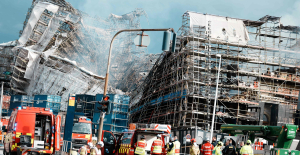 The main facade of the old Copenhagen Stock Exchange collapsed, two days after the fire started
The main facade of the old Copenhagen Stock Exchange collapsed, two days after the fire started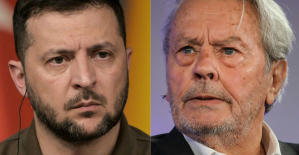 Alain Delon decorated by Ukraine for his support in the conflict against Russia
Alain Delon decorated by Ukraine for his support in the conflict against Russia Who’s Who launches the first edition of its literary prize
Who’s Who launches the first edition of its literary prize Sylvain Amic appointed to the Musée d’Orsay to replace Christophe Leribault
Sylvain Amic appointed to the Musée d’Orsay to replace Christophe Leribault Skoda Kodiaq 2024: a 'beast' plug-in hybrid SUV
Skoda Kodiaq 2024: a 'beast' plug-in hybrid SUV Tesla launches a new Model Y with 600 km of autonomy at a "more accessible price"
Tesla launches a new Model Y with 600 km of autonomy at a "more accessible price" The 10 best-selling cars in March 2024 in Spain: sales fall due to Easter
The 10 best-selling cars in March 2024 in Spain: sales fall due to Easter A private jet company buys more than 100 flying cars
A private jet company buys more than 100 flying cars This is how housing prices have changed in Spain in the last decade
This is how housing prices have changed in Spain in the last decade The home mortgage firm drops 10% in January and interest soars to 3.46%
The home mortgage firm drops 10% in January and interest soars to 3.46% The jewel of the Rocío de Nagüeles urbanization: a dream villa in Marbella
The jewel of the Rocío de Nagüeles urbanization: a dream villa in Marbella Rental prices grow by 7.3% in February: where does it go up and where does it go down?
Rental prices grow by 7.3% in February: where does it go up and where does it go down? With the promise of a “real burst of authority”, Gabriel Attal provokes the ire of the opposition
With the promise of a “real burst of authority”, Gabriel Attal provokes the ire of the opposition Europeans: the schedule of debates to follow between now and June 9
Europeans: the schedule of debates to follow between now and June 9 Europeans: “In France, there is a left and there is a right,” assures Bellamy
Europeans: “In France, there is a left and there is a right,” assures Bellamy During the night of the economy, the right points out the budgetary flaws of the macronie
During the night of the economy, the right points out the budgetary flaws of the macronie These French cities that will boycott the World Cup in Qatar
These French cities that will boycott the World Cup in Qatar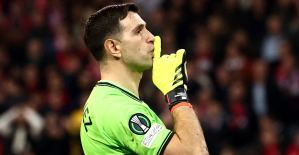 Europa Conference League: the semi-final flies to Lille, which loses to the wire against Aston Villa
Europa Conference League: the semi-final flies to Lille, which loses to the wire against Aston Villa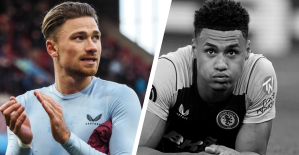 Lille-Aston Villa: Cash disgusts Lille, the arbitration too... The tops and the flops
Lille-Aston Villa: Cash disgusts Lille, the arbitration too... The tops and the flops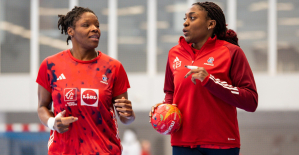 Handball: Les Bleues in the same group as Spain at Euro 2024
Handball: Les Bleues in the same group as Spain at Euro 2024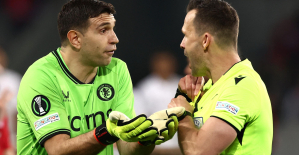 Europa Conference League: for Létang, Martinez “does not have the attitude of a high-level athlete”
Europa Conference League: for Létang, Martinez “does not have the attitude of a high-level athlete”


















